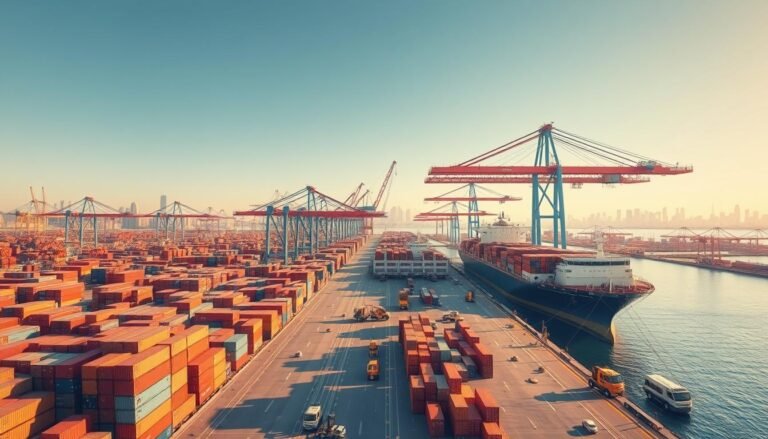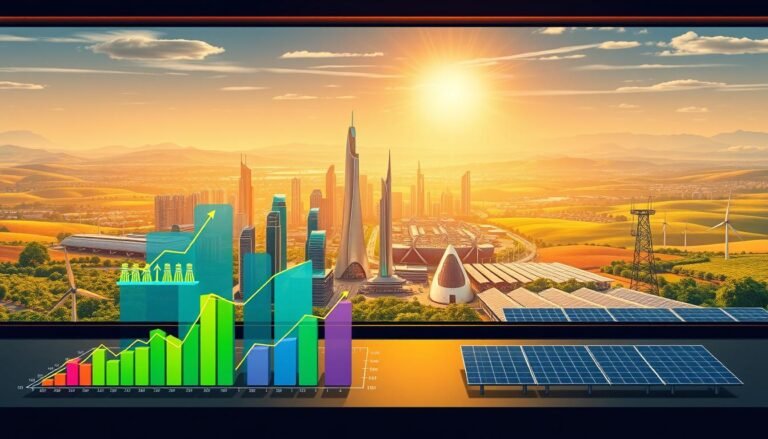Investing in tourism infrastructure
Can better roads and hotels really turn a small town into a global travel hotspot? The answer lies in how destinations invest in tourism infrastructure—the backbone of visitor experiences. With tourism contributing 9.1% to global GDP in 2023, smart infrastructure investments are no longer optional but essential. Countries like Saudi Arabia are proving this: their Vision 2030 plans to raise tourism’s GDP share from 3% to 10% by 2030, targeting 100 million annual visitors.
Yet, success isn’t just about numbers. In Peru’s Kuelap, a $27 million cable car system slashed travel time, boosting visitors by 156% between 2014 and 2017. This shows how strategic tourism infrastructure investments unlock economic potential.
Investing in tourism infrastructure isn’t just about building more hotels. It’s about creating ecosystems that attract travelers while preserving local cultures. From Peru’s mountain cable cars to Saudi Arabia’s UNESCO sites like Mada’in Saleh, infrastructure shapes how the world experiences a destination. But how do you balance modernization with sustainability? And what role do public-private partnerships play in funding these projects?
Key Takeaways
- Tourism infrastructure investments drive economic growth, with global FDI in tourism reaching $61.8 billion in 2019.
- Projects like Saudi Arabia’s Al-Ula and Peru’s Kuelap demonstrate how infrastructure boosts visitor numbers and local jobs.
- Quality infrastructure directly impacts GDP contributions—travel tech startups alone saw $450 billion invested from 2014–2019.
- Public-private partnerships are vital for funding projects like NEOM’s Sindala Island or airport upgrades in Jaén and Chachapoyas.
- Infrastructure development must align with cultural preservation, as seen in Saudi Arabia’s restoration of UNESCO sites like Al-Balad.
Understanding Tourism Infrastructure: The Foundation of Visitor Experiences
Good tourism infrastructure planning makes travel better. It includes everything from roads to restrooms. Knowing these parts is key to a great trip.
Types of Tourism Infrastructure Components
- Transportation: Airports, highways, and public transit connect visitors to attractions.
- Accommodation: Hotels, campsites, and vacation rentals offer safe, accessible stays.
- Support Services: Restaurants, information centers, and Wi-Fi hotspots enhance daily experiences.
- Attraction Infrastructure: Museums, parks, and guided tour systems draw repeat visits.
Why Quality Infrastructure Matters to Tourists
Good facilities make trips better. Clean restrooms and easy-to-follow signs help a lot. For example, fast public transit means less waiting.
Safe paths and always-on lighting make places feel safer. This encourages people to stay longer.
The Relationship Between Infrastructure and Destination Appeal
Places with good infrastructure get better reviews. A study found 78% of U.S. travelers value clean facilities. Without them, even beautiful spots can be a letdown.
But, smart investments like green shuttles or trails attract more visitors. They appeal to those who care about the environment and families.
The Economic Case for Investing in Tourism Infrastructure
Investing in tourism infrastructure boosts local economies. In West Virginia, the Tourism Works program has made a big difference. It’s a $5.1 million effort that has seen visitor spending jump 23% to $6.3 billion in 2023.
This growth is thanks to better trails, training, and marketing. Improved roads, parks, and amenities draw more visitors. More visitors mean more money spent at local shops and restaurants.
Every dollar spent on tourism creates $0.89 in local economic activity, says the OECD. This leads to jobs in hospitality, retail, and transportation. In West Virginia, tourism is expected to create 21,000 jobs by 2030, with some paying up to $60,000 a year.
Programs like “Train Your Team” help businesses grow. They can serve more tourists, boosting the economy even more.
| Year | Visitor Spending | Job Growth |
|---|---|---|
| 2019 | $5.1B | 15,000 jobs |
| 2023 | $6.3B (+23%) | 18,000 jobs |
Tourism infrastructure does more than just create jobs. It makes local economies stronger all year. In Costa Rica, eco-tourism turned small farms into attractions.
In Bali, hotel expansions created jobs even when it was slow. These stories show that smart investments in tourism can make a big difference. They turn visitors into long-term assets, helping farmers and artisans.
Let the numbers tell the story. Investing in travel-ready foundations is key to thriving communities.
Assessing Your Destination’s Infrastructure Needs
Before investing in tourism infrastructure, it’s crucial to understand what you already have. Knowing what visitors expect helps plan better. This means looking closely at where changes will have the biggest effect.
Conducting Audits to Reveal Opportunities
Start by checking out your current facilities. Look at transportation, cultural spots, and more. Compare your place to others in the industry. For instance, Singapore’s Changi Airport grew by understanding its needs.
Focus on these key areas:
- Transport links like airports and public transit
- Accommodation availability across budget and luxury tiers
- Visitor amenities like signage and accessibility features
Identifying Critical Gaps
Insights from data show where to make the biggest improvements. Keep an eye on:
- Visitor complaints from reviews
- Seasonal demand changes
- Broken infrastructure that hurts repeat visits
Places like Barcelona have tackled issues by enhancing attractions outside busy areas.
Prioritizing for Maximum Impact
Feedback from visitors guides your choices. Use surveys, social media, and direct talks to find out what’s bothering them. Focus on solving these problems first. This way, your investments meet visitor needs and help your destination grow.
Strategic Planning for Tourism Infrastructure Development
Effective tourism infrastructure planning needs a clear plan. It must balance growth with community needs. The U.S. Department of Transportation’s updated National Travel and Tourism Infrastructure Strategic Plan (NTTISP) shows this is urgent. It focuses on sustainable tourism development investments to boost travel after the pandemic.
With $5.6 billion for tourism projects in FY2022, having a solid plan is key. It helps make the most of these funds.
Creating a Master Tourism Infrastructure Plan
A master plan combines transportation, lodging, and amenities into one vision. The NTTISP aims to improve connections between modes of transport. This reduces traffic and supports goals like better rail links to national parks.
Getting feedback from the public and analyzing data is important. Even though the DOT lacks some data, it helps set priorities. Plans include early wins, like fixing visitor centers before tackling bigger projects.
Aligning Infrastructure with Destination Branding
- Eco-destinations should show their green side with solar power or trails that keep nature intact.
- Historical sites need clear signs and easy access to share their stories.
- Urban areas might focus on walkable areas with tech to help visitors navigate.
Investments that match a destination’s brand attract more visitors. This includes adventure seekers or those interested in history.
Setting Realistic Development Timelines
Seasonal changes mean plans must be flexible. For example, ski resorts plan construction around the off-season. Public-private partnerships can speed up projects, like Texas’s $120M River Walk upgrade.
Being open about plans builds trust with stakeholders. It also helps avoid spending too much.
Financing Options for Tourism Infrastructure Projects
Getting the right funding is crucial for making tourism projects happen. Whether it’s expanding a historic site or improving visitor services, looking into various financing tourism projects options is essential. This keeps your project on track.
- Government Programs: Federal grants and low-interest loans, like the U.S. DOT’s TIFIA, offer vital support. States also have tax incentives and funds for tourism to boost local economies.
- Private Lenders: Commercial banks and specialized lenders offer flexible terms. They are great for mid-sized projects needing quick approval.
- Public-Private Partnerships (PPPs): Shared investments reduce risk. For example, resorts often partner with local governments to fund attractions. These attract visitors and investors alike.
- Equity Investments: Private investors take ownership stakes, providing capital without debt. Equity is popular for ventures with high potential, like eco-resorts.
- International Funding: Organizations like the World Bank and regional development banks offer grants and technical support. They focus on sustainable tourism infrastructure funding initiatives.
Finding the right funding mix for your project involves looking at risks, repayment terms, and long-term goals. Showcasing projected visitor growth or community benefits can strengthen grant and loan applications. Whether using federal programs or private equity, making smart choices ensures your project adds lasting value.
Public-Private Partnerships in Tourism Infrastructure
Public-private partnerships (PPPs) help fill gaps in government budgets and private investment. They use financing tourism projects and ensure benefits for the community. Governments get access to private innovation, and investors get long-term returns through shared risks and rewards.
Good PPPs start with clear agreements. Contracts must define roles, timelines, and how profits will be shared. For example, North Toraja Regency in Indonesia used the Life Cycle Contract (LCC) model. This effort boosted visitor numbers from 164,421 in 2016 to 365,554 by 2019, showing the power of public-private partnerships in tourism infrastructure to grow.
- Singapore’s Resorts World Sentosa: A $5.8 billion project funded through PPPs, creating 16,000 jobs and attracting 18 million annual visitors.
- Salta Province, Argentina: The Tourism Development Policy (PDT) leveraged PPPs to generate 1,376 direct jobs in tourism, with 50% in hospitality.
Regulatory hurdles like permits and environmental rules often slow PPP progress. To succeed, partners must align policies with project goals. For instance, Dubai’s 2030 tourism strategy included streamlined regulations, enabling rapid expansion of hotels and transit networks. Transparency in contracts is crucial—it prevents disputes and builds trust.
PPPs work best when all parties share data, clarify financial expectations, and listen to community input. The Salta PDT’s tax incentives and marketing campaigns show how policy frameworks can attract private investors while protecting local culture. By combining these elements, PPPs turn infrastructure challenges into opportunities for sustainable tourism growth.
Investing in Tourism Infrastructure for Sustainable Growth
Today’s travelers want experiences that care for the planet. Sustainable tourism infrastructure is key to attracting visitors and protecting resources. Over 87% of global travelers prefer eco-conscious trips, making
Starting with eco-friendly design is crucial for investing in tourism infrastructure. Use solar panels, rainwater systems, and locally sourced materials to save money and the environment. Resorts and hotels that are carbon-neutral and eco-certified show the benefits of green practices.
- Energy-efficient lighting reduces bills while lowering emissions.
- Water recycling systems cut usage by 30% in some hotels.
- Green certifications like LEED or Green Globe signal commitment to travelers.
Development must protect ecosystems. Protecting coral reefs near beaches or preserving hiking trails keeps destinations intact for future visitors. Working with local communities ensures cultural landmarks and natural areas stay intact.
Long-term success needs resilience. Climate-ready buildings withstand storms, and smart tech like IoT sensors monitor resource use. Lifecycle analysis helps choose materials that last longer, saving money over time.
Investments in sustainable tourism infrastructure also mean ethical practices. Projects in regions like the Dominican Republic’s Cibao and Valdesia regions show how solar-powered lodges and community-run eco-tours thrive. These examples prove that balancing profit with preservation is achievable.
Technology Integration in Modern Tourism Infrastructure
In today’s world, technology is changing how places attract and serve visitors. Smart systems like AI chatbots, mobile apps, and IoT devices are key parts of tourism infrastructure investments. KLM’s Facebook Messenger service and Meliá Hotels’ data-driven marketing show how tech improves guest happiness and work flow.

- AR/VR tools: Companies like Everest offer virtual tours, while hotels use VR for room previews.
- IoT devices: Smart thermostats and luggage tracking systems make guests more comfortable.
- AI chatbots: IBM’s Watson Assistant offers 24/7 customer service in airports and resorts.
- Blockchain: It makes payments and loyalty programs safer, reducing fraud risks.
Good tourism development investments need strong broadband and cybersecurity. For example, 5G makes data processing faster, helping with apps and live streaming. Places with strong ICT infrastructure see up to 15% more visitors because of quick booking and reliable internet.
Future infrastructure must also be green. Electric vehicle charging stations, solar-powered lights, and AI for energy use reduce harm to the environment. As people want services without touching things and personal experiences right away, adding tech early helps infrastructure stay flexible. From voice-controlled rooms to blockchain-tracked carbon credits, these innovations make visitor dreams real.
Transportation Infrastructure: The Gateway to Tourism Success
Effective tourism infrastructure planning begins with smooth transportation. Airports, roads, and public transit are key first impressions for visitors. Bad connections can scare off travelers, while good ones make places more accessible and safe.
In places like Kinnaur’s National Highway-22, bad roads led to 213 accidents from 2015 to 2020. This shows the importance of tourism infrastructure investments in making roads better. On the other hand, a survey of 280 tourists showed Kalpa’s transport was better than nearby areas, showing how improvements can please visitors.
Steps to success include:
- Expanding airports with designs that show off local culture (e.g.,Dubai’s airport expansions)
- Improving road networks with safety features and scenic paths
- Starting electric bus services, like Kinnaur’s, to meet eco and access needs
Systems like Chicago’s Skyway Bridge, which links toll roads with public transit, show the value of mixing options. Bad planning, like Brisbane’s unused Airportlink M7, can lead to financial losses. Reliable transit reduces traffic and makes the first impression better.
Rural tourism has grown to 22% of bookings since 2015. Investing in bridges, signs, and digital tools like transit apps is key. With the right upgrades, transport systems can draw in visitors and ensure safe, memorable trips.
Accommodation and Hospitality Infrastructure Development
Accommodation is key to tourism growth. Most global investment in tourism goes to hotels and lodges. Investing in better places to stay can make visitors happier and help the economy.
There are many types of places to stay that travelers want. Think about glamping, serviced apartments, and eco-lodges. Also, hotels with shops, restaurants, and entertainment are great for local businesses.
| Type | Opportunities |
|---|---|
| Luxury Resorts | High-end amenities, weddings, corporate events |
| Boutique Hotels | Local culture integration, unique guest experiences |
| Short-Term Rentals | Flexibility for travelers, seasonal demand alignment |
| Wellness Retreats | Health-conscious travelers, spa services, yoga programs |
Technology makes staying in hotels better. Guests like mobile check-ins and smart rooms. Hotels that care for the environment are also popular.
Investors should think about where to build, local rules, and how to manage places long-term. It’s important to plan how to make money and help the community.
Cultural and Recreational Tourism Infrastructure
Cultural and recreational facilities are key for unique travel experiences that celebrate local heritage. Well-planned tourism infrastructure investments in museums, parks, and historic sites can boost local economies. In Croatia, investments in cultural centers and hiking trails have increased visitor numbers while preserving traditions.
Museums, Theaters, and Cultural Centers
Modern museums engage visitors with interactive tech. They must adapt for events and exhibits, with areas for revenue like gift shops. Theaters succeed by mixing local arts with tech, like virtual reality storytelling.
Sports Facilities and Adventure Tourism
Adventure parks with climbing walls or mountain bike trails attract thrill-seekers. Sustainable designs, like eco-friendly pathways, ensure long-term use. Public-private partnerships fund these projects, balancing profit and preservation.
Heritage Site Infrastructure
Protecting historic sites requires careful planning. Visitor centers with guided tours and signage educate without damaging sites. A study of 312 Croatian tourism managers found that 78% see private funding as key to heritage upkeep. Smart infrastructure like timed entry systems reduces overcrowding.
Successful projects blend local identity with global appeal. From theaters to hiking paths, these investments create jobs in guiding and crafts while showcasing cultural pride. Done right, they turn heritage into a shared treasure for locals and visitors alike.
Measuring ROI on Tourism Infrastructure Investments
To understand the economic impact of tourism infrastructure, we need clear ways to measure it. First, look at direct gains like more spending by visitors and new jobs. Input-output analysis is a tool that shows how these investments affect local economies.
| Year | State Funding | Private Funding | ROI Multiplier |
|---|---|---|---|
| FY 2010-11 | $26.6M | $57.1M | 3.2 |
| FY 2011-12 | $34.9M | $94.3M | 3.2 |
| FY 2012-13 | $54.0M | $108.6M | 3.2 |
Important metrics include how many visitors come and how much they spend. In 2015, Florida’s $84.6M tourism budget led to 105M visitors. This shows how smart spending can increase visits.
Look beyond just hotel stays to see how tourism affects the community. For example, leisure travelers spent $651B compared to $296B by business travelers. Also, $147.9B in taxes funded schools and roads.
It’s also important to consider the downsides, like overcrowding. But, tools like the Community Vitality Wheel help see the good, like preserving culture and improving life quality. Colorado, for example, got $25 in taxes for every dollar invested in tourism.
Good measurement combines financial gains with quality improvements. By using data and clear reports, places can show how tourism infrastructure investments make destinations better for everyone.
Common Pitfalls in Tourism Infrastructure Projects
Effective tourism infrastructure planning means knowing what to avoid. Many projects fail because of small mistakes or quick decisions. Here are some common risks and how to fix them:
| Pitfall | Impact | Solution |
|---|---|---|
| Ignoring market research | Misaligned facilities with traveler preferences | Survey visitor needs before construction |
| Poor digital presence | Low online visibility | Invest in user-friendly websites with booking tools |
| Skipped maintenance budgets | Infrastructure decay | Budget 10-15% of project costs for upkeep |
| Regulatory delays | Project holdups and cost overruns | Engage legal experts early in tourism development investments |
| Weak stakeholder collaboration | Conflict and resource waste | Form advisory committees with local communities |
| Inadequate staff training | Poor service quality | Train staff on customer service and safety protocols |
By taking proactive steps like regular checks and having a backup fund, you can lower risks. A 2023 UNWTO report shows over 40% of failed projects were due to bad maintenance planning. By tackling these issues early, places can turn potential failures into chances for lasting growth.
Tourism Infrastructure Funding Programs in the United States
There are many ways to fund tourism infrastructure funding at the federal, state, and local levels. These programs help local economies grow by supporting projects like visitor centers and trails. They also improve transportation links.
The Travel, Tourism & Outdoor Recreation program at the federal level offers $750 million in grants. This includes $510 million for state grants and $240 million for competitive grants. The Build Back Better Regional Challenge gives $1 billion for regional projects. The Good Jobs Challenge invests $500 million in tourism job training.
At the state level, Tennessee’s Tourism Enhancement Grants have given over $1 million to 29 communities. These grants help with trail improvements and hosting events. The Rural Economic Opportunity Act also supports infrastructure in rural areas. Awards can go up to $24,000, decided by state committees.
Local governments use tools like hotel occupancy taxes and special purpose sales taxes for funding. In 2023, Tennessee funded 37 projects, including infrastructure and events that drew 86,500 visitors. A virtual session on January 25, 2024, will help with grant applications. The deadline is February 23, 2024, so applicants need to act fast.
Successful projects often use a mix of federal, state, and local funds. For example, event organizers might use state grants and local taxes together. Detailed guidelines for these programs are on state tourism websites. They focus on projects that increase visitation and boost the economy.
Future Trends in Tourism Infrastructure Development
Looking ahead, sustainable tourism infrastructure and tourism infrastructure planning are evolving. Trends like AI services and eco-friendly designs are changing how places welcome guests. With 74% of travelers caring about the environment, smart and strong designs are now a must.
- AI integration: Generative AI in travel is set to grow from $894M to $5B by 2034, streamlining bookings and personalizing experiences.
- Climate-ready facilities: Cooling systems and flood-resistant buildings will protect against extreme weather.
- Smart cities: Markets like Singapore’s Changi Airport, using solar panels and green tech, show how sustainable tourism infrastructure boosts appeal.
| Trend | Key Data |
|---|---|
| Smart City Tech | Market value: $552B in 2024, growing at 16% annually |
| Wellness Tourism | Market to hit $1.4T by 2027 via eco-lodges and nature-focused stays. |
| Digital Nomads | Population to rise to 60M by 2030, needing co-working spaces and tech hubs. |
Community-focused tourism infrastructure planning is crucial. Rwanda’s gorilla tourism, which sends 10% of revenue to locals, shows how to balance profit with social good. As travel picks up, mixing innovation with environmental care will keep places attractive. Being flexible in planning lets infrastructure adjust to climate changes and changing traveler needs.
Conclusion: Building a Foundation for Tourism Success
Investing in tourism infrastructure is more than just building roads or hotels. It’s about creating jobs and boosting local economies. In the U.S., smart investments in transport and attractions can lead to big economic wins.
For example, Spain’s “Fair Hotels” program improved jobs and made tourism stronger. This shows how the right investments can make a big difference.
Worldwide, good tourism infrastructure is key to growth. The travel sector added 23.2% to global GDP in 2023. This shows its huge economic impact.
In places like the Maldives, tourism is a big part of the economy. Strong infrastructure is crucial for keeping tourism sustainable. Tajikistan’s work on cultural sites is a great example of how to do this right.
Looking ahead, we need to focus on being green and involving local communities. The World Bank supports this with its public-private partnerships. This ensures projects meet visitor needs and long-term goals.
By using technology and energy-saving measures, destinations can attract visitors. They can also create jobs and protect the environment. This is how we build a strong future for tourism.
Tourism infrastructure is a key to solving today’s problems and opening up new opportunities. When done right, it helps communities, grows economies, and creates lasting memories for visitors. Making smart investments now will help destinations stay competitive in the future.
Source Links
- What is the concept of Tourism Investment? – https://www.linkedin.com/pulse/what-concept-tourism-investment-ndf-s8dce
- Enabling Frameworks for Tourism Investment – http://www.unwto.org/investment/un-tourism-investment-guidelines-SA1
- The effect of infrastructure investment on tourism demand: a synthetic control approach for the case of Kuelap, Peru – https://pmc.ncbi.nlm.nih.gov/articles/PMC9713178/
- Tourism Infrastructure: Explained & Impact – https://www.vaia.com/en-us/explanations/hospitality-and-tourism/tourism-infrastructure/
- Building the Foundation: The Role of Infrastructure in Tourist Transport • The Tourism Institute – https://thetourism.institute/tourist-transport-operations-road-transport/infrastructure-role-tourist-transport-development/
- West Virginia – Innovative Travel, Tourism, and Outdoor Recreation Case Study – https://www.nga.org/updates/west-virginia-innovative-travel-tourism-and-outdoor-recreation-case-study/
- PDF – https://nawalaeducation.com/index.php/JT/article/download/510/566/2271
- No title found – https://www.elibrary.imf.org/view/journals/022/0004/001/article-A001-en.xml
- PDF – https://wttc.org/Portals/0/Documents/Reports/2019/Global Cities Readiness For Tourism Growth-Jun 2019.pdf?ver=2021-02-25-182751-627
- Tourism Infrastructure Development: Opportunities in Hospitality and Accommodation – https://medium.com/@ameliavitory/tourism-infrastructure-development-opportunities-in-hospitality-and-accommodation-1e71883740f2
- National Travel & Tourism Infrastructure Strategic Plan Update — DOT seeks input (by 7/17) – https://www.aeaweb.org/forum/3768/national-travel-tourism-infrastructure-strategic-update
- Travel and Tourism: DOT Should Improve Strategic Planning and Data Collection – https://www.gao.gov/products/gao-23-105967
- Tourism property: financing and investment loans – https://esfccompany.com/en/articles/infrastructure/tourism-property-financing-and-investment-loans/
- Financing for tourism properties – https://viola-funding.com/2024/04/21/investment-loans-and-financing-for-tourism-property/
- Public-Private Tourism Partnerships: Importance & Role – https://www.vaia.com/en-us/explanations/hospitality-and-tourism/tourism-education-and-research/public-private-tourism-partnerships/
- PDF – https://enrichment.iocspublisher.org/index.php/enrichment/article/download/107/79
- Tourism development through PPPs: An opportunity to generate employment in Latin America and the Caribbean? – https://idbinvest.org/en/blog/development-impact/tourism-development-through-ppps-opportunity-generate-employment-latin
- Infrastructure promoting Sustainable Tourism Development | Private Finance for the SDGs – http://sdgprivatefinance.undp.org/leveraging-capital/sdg-investor-platform/infrastructure-promoting-sustainable-tourism-development
- Investing in the Tourism Sector: ESG as a Key Value for Tourism 2030 – https://www.linkedin.com/pulse/investing-tourism-sector-esg-key-value-2030-innvest-dunke
- The New Technology and Travel Revolution – https://www.wearemarketing.com/blog/tourism-and-technology-how-tech-is-revolutionizing-travel.html
- The impacts of ICTs on tourism development: International evidence based on a panel quantile approach – https://pmc.ncbi.nlm.nih.gov/articles/PMC8562381/
- 21 Key Technology Trends Emerging in the Travel Industry in 2025 – https://www.revfine.com/technology-trends-travel-industry/
- The role of transportation in developing the tourism sector at high altitude destination, Kinnaur – https://pmc.ncbi.nlm.nih.gov/articles/PMC10014399/
- Tourist trap? Investing in tourism infrastructure – https://blogs.worldbank.org/en/ppps/tourist-trap-investing-in-tourism-infrastructure
- PDF – https://wttc.org/Portals/0/Documents/Reports/2021/Investing in Travel and Tourism 100921.pdf?ver=2021-09-16-112521-367
- Investment Potential in Tourism Infrastructure Beyond Accommodation – https://iips.com.pk/investment-potential-in-tourism-infrastructure-beyond-accommodation/
- (10 pt) – https://hrcak.srce.hr/file/294885
- Establishing Sustainable Tourism Infrastructure is Essential for Development – https://www.irancharter.ir/en/news/establishing-sustainable-tourism-infrastructure/
- Return on Investment for VISIT FLORIDA – https://edr.state.fl.us/Content/returnoninvestment/Tourism.pdf
- If We Say Tourism Builds Community, How Do We Prove It? – https://destinationsinternational.org/blog/if-we-say-tourism-builds-community-how-do-we-prove-it
- Measuring the Economic Benefits of Tourism – Hotel & Leisure Advisors – https://hladvisors.com/measuring-the-economic-benefits-of-tourism/
- Tourism Development Mistakes to Avoid – https://uncorneredmarket.com/work-with-us/tourism-development-mistakes-to-avoid/
- Public Tourism Infrastructure: Challenges in the Development and Maintenance Activities – https://www.shs-conferences.org/articles/shsconf/pdf/2014/09/shsconf_4ictr2014_01096.pdf
- EDA OPENS GRANT FUNDING FOR TOURISM RECOVERY | NJTIA – https://www.njtia.org/press-releases/eda-opens-grant-funding-for-tourism-recovery/
- Governor Haslam, Commissioner Boyd Announce 29 Communities to Receive Tourism Enhancement Grants – News – Tennessee Department of Economic and Community Development – https://tnecd.com/news/governor-haslam-commissioner-boyd-announce-29-communities-to-receive-tourism-enhancement-grants/
- Apply Now for 2024 NYS Canal System Tourism Infrastructure and Events Grants – https://www.nystia.org/resources/apply-now-for-2024-nys-canal-system-tourism-infrastructure-and-events-grants
- Tourism industry trends for 2025 – AI, sustainability, and emerging travel norms – https://blog.smart-guide.org/en/tourism-industry-trends-2025-ai-sustainability-emerging-travel-norms
- PDF – https://reports.weforum.org/docs/WEF_Future_of_Travel_and_Tourism_2025.pdf
- Now boarding: Faces, places, and trends shaping tourism in 2024 – https://www.mckinsey.com/industries/travel/our-insights/now-boarding-faces-places-and-trends-shaping-tourism-in-2024
- Importance of Tourism Infrastructure Development – https://www.mywestford.com/blog/importance-of-tourism-infrastructure-development/
- Microsoft Word – Final HLTD on Tourism – Summary FINAL – https://www.un.org/pga/76/wp-content/uploads/sites/101/2022/06/HLTD-on-Tourism-Summary.pdf








